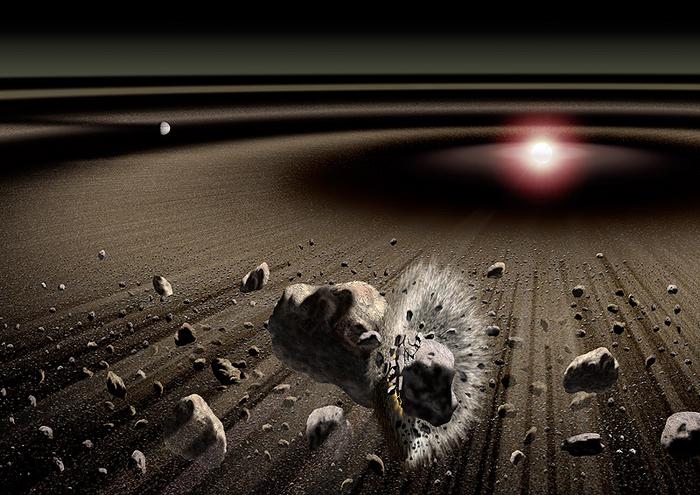
Understanding the origins of Earth’s essential elements has inspired compelling scientific investigations for decades. Recently, a groundbreaking study conducted by a team led by researchers from Arizona State University has offered fresh perspectives on how these critical components were integrated into the planets. Traditional models proposing that Earth and Mars are deficient in moderately volatile elements (MVEs) have come under scrutiny due to the insights provided by this new research. This signifies a potential paradigm shift in our understanding of planetary formation and accretion processes in the early solar system.
Moderately volatile elements, which include vital components such as copper and zinc, are fundamental to planetary chemistry and play a crucial role in the conditions necessary for life to flourish. Nonetheless, both Earth and Mars exhibit notably lower concentrations of MVEs when compared to primitive meteorites known as chondrites. The discrepancy raises significant questions regarding the mechanisms underlying planetary assembly and the elemental composition of terrestrial bodies.
The team, spearheaded by Assistant Professor Damanveer Grewal from the School of Molecular Sciences and the School of Earth and Space Exploration at Arizona State University, collaborated with distinguished scientists from institutions like Caltech, Rice University, and MIT. Their research, published in the prestigious journal Science Advances, shifts the narrative surrounding MVEs by leveraging data derived from iron meteorites. These remnants are considered to be the metallic cores of the earliest planetesimals—primitive bodies that contributed to the building of planets.
Grewal and his colleagues uncovered compelling evidence indicating that first-generation planetesimals in the inner solar system were surprisingly enriched in these crucial elements. This revelation contests previous beliefs that Earth and Mars lost their MVEs due to incomplete condensation during the solar system’s formative stages or as a result of differentiation processes that occurred among planetesimals. The findings suggest that a significant amount of MVEs was retained within these early building blocks, which challenges the long-held perspective of elemental depletion during planetesimal evolution.
The methodology employed in this study was centered around computational simulations and models that scrutinized the element distributions within iron meteorites. This analytical approach sought to reconstruct the conditions and processes influencing element retention during the early stages of planetary formation. By focusing on this unique subset of meteorites, the research team provided novel insights into the chemical makeup of the materials that seeded the inner solar system.
One of the most striking outcomes of the research is the discovery that many inner solar system planetesimals retained MVE abundances akin to those found in chondrites. This suggests that the initial precursors to Earth and Mars entered the planetary assembly process with appreciable quantities of these elements. The implication is not merely academic; it fundamentally alters our comprehension of how the essential ingredients for life became unevenly distributed between different planetary bodies in our solar system.
Grewal emphasized that their research significantly redefines how scientists understand the chemical evolution of rocky planets. Instead of adhering to the narrative that MVEs were merely lost through various differentiation processes or volatile escape, this new framework posits that the loss of these elements happened much later, during a period marked by intense, violent collisions which were instrumental in shaping the planets’ geochemical characteristics.
This shift in perspective opens up exciting avenues for future inquiry. Understanding how these collisions influenced the elemental compositions of terrestrial planets may help scientists identify the processes that led to the distinct geological and biological pathways that define Earth today. Furthermore, this knowledge lays the groundwork for more comprehensive models that can elucidate the complex interplay between cosmic events and planetary development.
In addition to the intellectual stimulation produced by these findings, there are broader implications for the search for habitable worlds beyond our own. Recognizing that planets can emerge from different degrees of elemental abundance can help astrobiologists refine their criteria for identifying other planets that may host conditions suitable for life. The elemental fingerprints left by these processes could provide significant clues when surveying exoplanets in distant solar systems.
The publication of this study represents a significant milestone in the field of planetary science. By synthesizing evidence from both astronomical observations and computational models, the research community is now encouraged to re-evaluate established ideas about planet formation. As researchers continue to delve deeper into the cosmic history of our solar system, they may yet unveil further surprises that enhance our understanding of the universe and its myriad processes.
As this discourse unfolds, the scientific community remains keenly aware of the collaborative efforts that underpin groundbreaking research such as this. The merging of disciplines—from molecular sciences to astrophysics—illustrates the need for an integrated approach that encompasses various fields of study to tackle the complex questions that linger about our origins and evolution.
In conclusion, this study presents a compelling narrative about the enrichment of moderately volatile elements within the first-generation planetesimals of the inner solar system. As scientists digest these findings, there will likely be a paradigm shift in how we interpret the elemental allocations of terrestrial planets. By continuing to probe the histories encoded within meteorites and other celestial materials, researchers hope to unlock the secrets of our cosmic beginnings, transforming our understanding of planet formation in profound ways.
Subject of Research: Enrichment of Moderately Volatile Elements in Planetary Formation
Article Title: Enrichment of Moderately Volatile Elements in First-Generation Planetesimals of the Inner Solar System
News Publication Date: February 5, 2025
Web References: Science Advances DOI
References:
Image Credits: Kouji Kanba
Keywords
Solar system evolution, Habitable planets, Planet Earth, Protoplanets, Iron meteorites, Discovery research, Astrochemistry, Planetary science, Space exploration, Space research.
Tags: Arizona State University research on elemental originschallenges to traditional models of planetary accretioncollaboration between leading scientific institutionsimpact of meteorite studies on planetary scienceimplications of copper and zinc in planetary chemistrymeteorite discoveries and planetary formationmoderately volatile elements in Earth and Marsnew insights into Earth’s essential elementsparadigm shift in solar system formation theoriessignificance of chondrites in understanding Earth’s compositionunderstanding life’s conditions through elemental analysis





